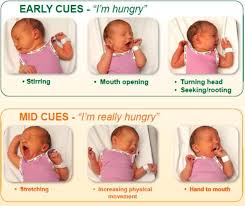How to Feed a Baby: A Guide to Breastfeeding and Formula Feeding
Feeding your baby is a crucial part of their development and essential for their growth and health. It can be a deeply rewarding experience for parents and babies alike, however, it can also be overwhelming. With the right guidance and resources, parents can navigate the journey of feeding their baby with confidence. We’ll now discuss the basics of baby feeding, from choosing the right products to understanding the nutritional needs of your baby. Please keep reading for details on the following topics:
How to feed a baby
Bottle feeding
Formula feeding
Hunger cues

HOW TO FEED A BABY
These steps are essential for ensuring a comfortable and hygienic breastfeeding experience for both the mother and the baby.
The hand must be washed and dried
Nipples must be cleaned with plain water and cotton or soft wash cloth
The woman should be sitting or laying comfortably on a chair or bed, with pillows supporting the neck and back
Baby must be held comfortable on the mother’s forearm, ensuring that the baby is supported
Allow the baby’s belly to touch the mother’s belly
The baby will be brought to the breast for breastfeeding
The woman who had a c section can tuck baby to her side (like a football) or lay on a side for breastfeeding
With the thumb and fingers around the areola the woman may tilt baby’s head back and tickle the lips with the nipple until the mouth is opened wide (rooting) for the breast
Insert the entire nipple and part of the areola into baby’s mouth, allowing the baby time to feed
When baby stops feeding and turns away from the nipple, this may be a sign that baby is done feeding or may need a break
To release the nipple from the baby’s mouth, hook out the nipple out of the baby’s mouth with a clean finger and allow baby to release the nipple
Bring baby gently to the shoulder or propped up on the knee and rub the back until trapped air escapes the mouth (burp) or the anus (fart)

BOTTLEFEEDING
Bottle feeding is an important part of caring for a new baby. It can provide a variety of nutritional benefits to give your baby the best start in life. Whether you choose to use infant formula, expressed breast milk, or a combination of both, bottlefeeding is an easy and convenient way to provide your baby with the nourishment they need. Bottlefeeding can help you to bond with your baby, and it is also a great way to involve other family members in feeding time.
BOTTLE FEEDING A BABY
These instructions outline the initial steps for bottle feeding.
- Wash and dry hands properly.
- Check that the formula hasn’t expired.
- Use a clean and sterilized bottle.
- Boil water for preparing the formula.
IF PREPARING THE FORMULA FROM SCRATCH
- Add the specified number of scoops of milk to the water in the bottle, according to the instructions on the label.
- Cover the bottle and shake well to mix the formula thoroughly.
- Cool down the bottle under running water or by placing it in a container of cool water to bring it to a suitable temperature for feeding.
OR
IF REWARMING FORMULA
Here are the steps for rewarming formula and feeding the baby:
- Ensure freshness: Do not use formula that has been out of the refrigerator for more than one hour.
- Heat the formula: Place the bottle under warm running water or in warm water to gently heat it.
- Check temperature: Test the temperature of the formula by squeezing a bit onto the wrist to ensure it is not too hot.
- Prepare for feeding: Sit in a comfortable position with the baby close to the caregiver’s belly and support the baby’s head in the crook of the arm.
- Encourage latching: Gently brush the nipple of the bottle against the baby’s lips until the mouth opens.
- Insert nipple: Insert the nipple into the baby’s mouth in a tilting position to ensure it is full of milk.
- Prevent air intake: Keep the nipple full so the baby cannot suck in air.
- Monitor feeding: Pay attention to cues indicating the baby may be done feeding. When baby stops sucking, it may be a sign that baby is done bottle feeding
- End feeding: When the nipple is empty, gently remove it from the baby’s mouth using a clean finger and allow the baby to release the bottle.
- Burp the baby: Bring the baby gently to the shoulder or prop them up on the knee and rub their back to help release trapped air from the mouth or anus.
- Discard remaining formula: Any remaining formula in the bottle must be discarded to maintain hygiene and freshness.
PRECAUTIONS WHEN BOTTLE FEEDING
These additional instructions provide important guidelines for feeding a baby safely and ensuring their nutritional needs are met.
- Avoid microwaving formula: Microwaving can cause uneven heating and burns to the baby’s mouth.
- Discard remaining formula: Do not reuse leftover formula as it may become contaminated.
- Wash and sterilize bottles: Prior to use, ensure feeding bottles are properly washed and sterilized to prevent infection.
- Feeding frequency: Feed the baby every 2 to 3 hours but avoid strict schedules; feed the baby as often and for as long as needed.
- Prevent long waits between feeds: Do not allow the baby to go more than 3 hours without feeding.
- Wake baby to eat: It’s acceptable to wake the baby for feeding if necessary.
- Limit fluids: For babies under 6 months old, only provide breast milk or formula; avoid giving water or other fluids.
- NEVER GIVE A BABY WATER: Water is unnecessary and potentially harmful for infants during this period, as it can fill their small stomachs without providing essential nutrients. It also helps prevent the dilution of the nutrients in breast milk or formula, which are crucial for the baby’s growth and development.
A BABY’S HUNGER CUES

We understand that parents want to provide their babies with the best care possible. That’s why we’re here to help you understand your baby’s hunger cues, so you can make sure they get the nutrition they need. We’ll help you identify the signs of hunger, learn to interpret your baby’s behavior, and know when it’s the right time to feed them. These are common hunger cues exhibited by babies.
- Stirring and stretching actions: Babies may show signs of restlessness and stretch their arms and legs when they are hungry.
- Smacking of the lips: Babies may smack their lips or make sucking sounds, indicating their desire to feed.
- Sucking gestures: Babies may suck on their fingers, fists, or other objects as a reflexive response to hunger.
- Sucking of the hand: Similar to sucking gestures, babies may suck on their hands as a hunger cue.
- Lip movements: Babies may make lip-smacking or tongue movements, indicating their readiness to feed.
- Crying or fussing: Crying or fussiness can also be a late hunger cue, indicating the baby’s discomfort and need for feeding.
- Rooting reflex: Babies may turn their heads and open their mouths in search of the breast when their cheeks or lips are touched, demonstrating the rooting reflex.
Disclaimer: The information provided in this content is for general informational purposes only. It is not intended as medical or healthcare advice, diagnosis, or treatment. Always seek the advice of a qualified healthcare professional with any questions you may have regarding a medical condition or healthcare decisions.

